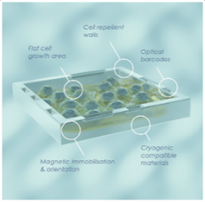
- Applications
-
Products
-
Liquid Handling
- firefly Accelerate genomic research with innovative all-in-one, compact liquid handling
- mosquito Nanolitre liquid handling technology performs ‘traditional’ tasks at a fraction of the volume, and higher speeds
- dragonfly Delivers accurate and repeatable nanolitre to milliliter dispensing
- apricot Automated liquid handling instrumentation for convenient general use across your entire team
- Sample Preparation
-
Sample Management
- comPOUND A scalable, reliable, and secure compound management solution
- BioMicroLab Easy-to-use sample management automation instruments
- arktic Robust biospecimen storage and management down to -80°C
- lab2lab Novel sample and data transfer network system
- comPACT Reliable and efficient -20°C storage and retrieval has never been more accessible
-
Liquid Handling
-
About
- Company With a focus on liquid handling, sample preparation and sample management, our expert teams create state-of-the-art solutions that scientists and researchers can trust Culture We have one overarching mission: to work together to accelerate life science research. Through our innovative solutions and state-of-the-art tools, we believe we can make a real difference to human health Partners Collaboration is key in our mission to make a real difference to human health. Partnering with application leaders globally, we co-create to solve new challenges across the life sciences. Innovation From the initial prototype through to manufacturing, installation and beyond, we bring a problem-solving mindset and technical expertise to drive innovation
-
Executive Leadership
 Through strategic guidance, visionary thinking, and a relentless pursuit of excellence, our senior executives steer SPT Labtech towards achieving its mission of making a real difference to human health through solving advanced laboratory challenges.
Learn more
Through strategic guidance, visionary thinking, and a relentless pursuit of excellence, our senior executives steer SPT Labtech towards achieving its mission of making a real difference to human health through solving advanced laboratory challenges.
Learn more 
-
View all
 Board of Directors
Board of Directors
 Our Board of Directors are committed to driving the long-term success and sustainability of SPT Labtech, providing expert guidance and oversight to execute the company’s ambitious commercial strategy.
Learn more
Our Board of Directors are committed to driving the long-term success and sustainability of SPT Labtech, providing expert guidance and oversight to execute the company’s ambitious commercial strategy.
Learn more 
-
Knowledge Base
- Resources Our wide range of insightful resources include videos, whitepapers, eBooks, application notes and more Events & Webinars Meet the SPT team at events all over the globe and virtually via our webinars Podcast We chat with innovators and leaders from across the community to gain their unique insights. News Latest news from SPT Labtech globally Blog Our latest blog posts feature trends in research, innovative techniques and new technology
-
22 September, 2025
 How Novartis Is Shaping the Future of Lab Automation Through Smart Sample Transport
Continue reading
How Novartis Is Shaping the Future of Lab Automation Through Smart Sample Transport
Continue reading 
-
09 July, 2025
 SPT Labtech and Semarion Collaborate to Advance Automated Cell-Based Assay Workflows
Continue reading
SPT Labtech and Semarion Collaborate to Advance Automated Cell-Based Assay Workflows
Continue reading 
-
23 June, 2025
 SPT Labtech Named Illumina Qualified Methods Provider Following Successful Automation of Illumina DNA Prep on firefly® Platform
Continue reading
SPT Labtech Named Illumina Qualified Methods Provider Following Successful Automation of Illumina DNA Prep on firefly® Platform
Continue reading 
10
- Careers
- Home
- Resources
Resources
Explore insightful resources that include videos, whitepapers, eBooks, application notes and more
- 3D Cell Culture
- Assay Setup
- Automated Assay Development
- Biostorage and Biobanking
- Chemical Crystallization
- Compound Management
- CryoEM
- Crystal Screen Optimization
- DNA Normalization
- DNA Quantification
- Hanging Drop Crystallization
- High Throughput Screening
- Lipidic Cubic Phase (in meso)
- Magnetic Bead Clean-up
- Medicinal Chemistry
- NGS Library Prep
- PCR and qPCR
- Protein Crystallography
- Reformat
- Sample Tracking
- Single Cell Genomics
- Single Particle Analysis
- Sitting Drop Crystallization
- Synthetic Biology
- Transcriptomics
- Tube Cap/Decap
- Tube Labeling
Quantification and subsequent normalization of nucleic acids are critical steps in many genomics applications. Conventional quantification workflows use high volumes of costly reagents and waste valuable DNA. Furthermore, highly viscous DNA samples pose a challenge for automated liquid handling. Significant increases in throughput together with reduced reagent costs and sample saving can be achieved using the combination of a mosquito® pipetting robot and a dragonfly® discovery dispenser.
Read moreThomas Brabbs, Senior Research Assistant at the Earlham Institute, presents a miniaturized version of the Illumina DNA Prep method that was developed in collaboration with SPT Labtech for the all-in-one firefly® liquid handling platform for genomics.
Read moreIn this two-part webinar, our Product Manager introduces the new apricot DC1 and provides practical guidance on making the switch from manual to automated pipetting.
Read moreAnne Hammerstein introduces apricot DC1 and highlights some of the key features and applications of the instrument.
Read moreThis 3-page product brochure provides an overview of the apricot S1 in one easy-to-read document.
Read moreThis two-page product brochure provides an overview of the apricot S3 in one easy-to-read document.
Read moreThis 2-page product brochure provides an overview of the apricot PP5 in one easy-to-read document.
Read moreAssociated with numerous benefits, automated liquid handlers are increasingly adopted in R&D laboratories to simplify the creation of complex multi-parameter experiments in a reproducible, reliable and robust manner, while freeing highly trained scientists from manual lab-work to focus on more skilled tasks of analysis of data and planning of experiments.
Read moreThis calculator compares a range of factors to determine if switching to automation could be cost and time-effective.
Read moreIntroducing our new auto-feed reservoir (AFR) module for dragonfly discovery. Offering: offline reagent supply, temperature control, and stirring.
Read moreLearn more about the needs for next-generation sequencing (NGS), the demand for high-throughput, low-cost, miniaturized sample preparation has increased both in academic and clinical settings.
Read moreAs the per base read cost of next generation sequencing (NGS) has decreased, the library preparation cost, especially in high-throughput applications, such as single-cell analysis, has become a larger portion of the total cost.
Read more
